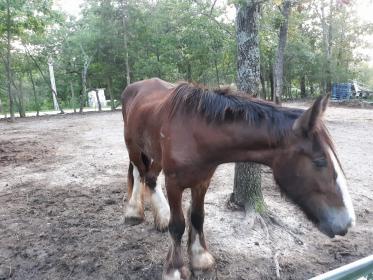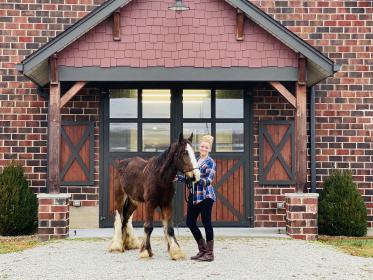Who here has any experience with super bad cow hocks!? I have a 2.5 year old Clydesdale mare her cow hocks are so bad they knock when she walks! To the point of her hocks are a little swollen! She was at the vet today and he really didn’t have any answers for me! Is there anything I can do? Orthopedic? Corrective farrier work? Help! She was a rescue and is pretty underweight so she has no muscle! Could this be why? She is also only 14.3 hands right now
When she gets stronger and fills out I would imagine it’s going to be less of an issue. I’ve seen draft breeds with cow hocks for years. One of the things I like about cow hocks is that I’ve never had a horse with stifle problems that have them. And they never needed to have their hocks dealt with with injections or anything either. Somehow, the ones that I’ve had I’ve done really well. Hang in there
I’m hoping this is the case! But she just looks so uncomfortable when she walks almost as to tuck her pelvis under her, and knock her hocks along with hit her front feet with her back! She’s very small and short backed for her age but she was very neglected! What should I do about her swollen hocks from knocking? Should I wrap? Leave them be? Stall her or turn her out?
Here she is

Generally, cow hocks are favored in draft horses because it enhances their ability to pull. Obviously your mare’s are very extreme, though. Not sure how/if they will get better as she ages.
I was hoping it was because of a muscling issue! But I have a feeling she will always be bad! I am heart broken

My mares became less pronounced as she got older and had more work under saddle. She was really weak as a young horse.
Cow hocks - hocks are closer together than the fetlocks. Cannon bones angle inward from the bottom up.
Close behind - vertical cannon bones, but legs very close together.
Toed-out - entire leg is rotated from the hip out, making hocks and fetlocks closer together (but the same as each other, vertical cannon bones) than the feet.
Get your girl some massage therapy, and wait for her to gain muscle and strength.
Lots of horses travel close behind when they are under-muscled and/or unfit.
And make 100% sure her feet are being trimmed to the leg, not just to make them point straight ahead.
She knocks them so bad when walking

She’s adorable! And she has no muscle across the top of her at all to help. She needs to put on weight and get some muscle. You don’t have anywhere near you where you could swim her do you? This time of year it’s got to be an equine indoor pool. Just asking
No I do not have anywhere like that for hundreds of miles!
Hmm, maybe one of those neoprene hockwraps? You could probably get away with putting it on just one hock and alternating it so it doesn’t get nasty under there. Would help cushion the knocking until she gets a bit more muscle/grows up a bit and you get a better idea of if she is going to grow out of it.
Hockshield Ultra’s would work for a bit of padding. They actually stay on great, but I was using them to deal with hock sores, which is what they’re designed for.
Does she also have sickle hocks? That last picture makes it look like she does, but it’s hard to tell from a close up like that.
In either case, I think you will see some improvement as she grows and gets some muscles, but she will probably always have some degree of cow hocks. Hopefully she’ll at least get to the point of not knocking them together when she walks.
As mentioned by someone else, it is part and parcel of draft horse conformation - that trait aids in getting traction to pull. In the mean time, feed her up with good quality hay, work her at a walk (good time to instill manners and teach her to follow you through all kinds of turns and back as well as forward) and wait. If you have small hills, walk her up and down them as well. She needs time more than anything
Her cannon bones appear parallel to each other. Not cow-hocked.
Also, you can’t tell sickle hocks from any of these pictures - need a straight on side view.
What I am going to write is a personal opinion only.
She is woefully underweight for a draft horse PLUS she has not grown much muscle.
I would not make a final judgment until her spine is no longer so prominent. She is lacking in muscle there as well as lacking in fat.
If you have hills nearby I would lead her up and down the hills at a walk while she is gaining weight and muscle mass. Start off slow, at a moderate slope and do it for a short time, and gradually increase the time you are walking up and down hill. If you have choices about slope gradually lead your horse up steeper slopes as she gains muscle. At the start it might well be a good idea to have some hock protection on her legs. After six months of this, as long as she also gains 50 to 100 lbs., there is a good chance that her hind legs won’t look quite as bad as they do now.
My first horse (Anglo-Arab) had bad cow hocks and sickle hocks (his saving grace was that his hock joints were nice and wide from side to side and front to back.) The worst problem his hocks had in 33 years was 2 or 3 times he ended up with capped hocks, which responded well to cold hosing for 20 minutes a day for a week or two. He did not get spavined at all, and for the first seven years I was jumping him 3’6". When he was in his mid to late twenties we would power TROT up the steepest slope I could find, but we worked up to that slowly. He was MUCH stronger by the time he able to comfortably trot fast uphill (we walked downhill.)
If it is any comfort your horse’s cow hocks may really help stability when going down a really, really steep hill.
The horse does not have cow hocks. It’s not even bred for in the breed. Close set hocks yes, but that is not cow hocks.
Cow hocks are not stable. They are a terrible fault.
